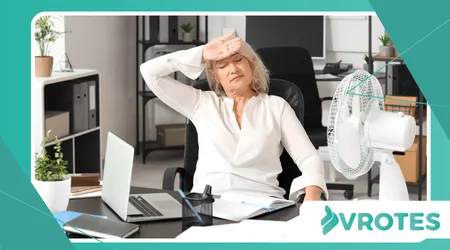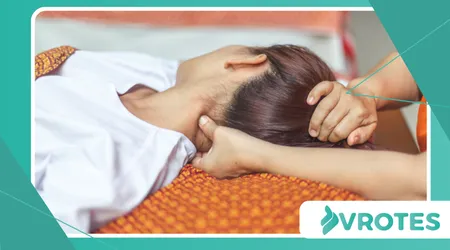Simple Desk Stretches to Relieve Menopausal Tension

Simple desk stretches to relieve menopausal tension. For countless women navigating the complexities of menopause, the workplace can become an unexpected source of discomfort.
Anúncios
The physical and emotional shifts that define this life stage, from hot flashes to mood swings, often manifest as a persistent, low-grade tension that settles in the neck, shoulders, and back.
This constant strain, exacerbated by hours spent hunched over a desk, can feel inescapable. But what if the solution was as close as your chair?
In this article, we’ll explore the power of simple desk stretches to relieve menopausal tension, offering a practical guide to reclaiming your comfort and focus without ever leaving your workspace.
The Silent Strain: Menopause and Muscular Discomfort
Menopause is a physiological transformation marked by hormonal fluctuations, primarily a decline in estrogen.
Anúncios
This hormonal shift can have widespread effects on the body, including changes to muscle and joint health.
Many women report increased stiffness, a reduced range of motion, and a heightened susceptibility to pain.
This is often tied to the role of estrogen in collagen production and its anti-inflammatory properties.
When estrogen levels drop, the connective tissues that support our muscles and joints can become less resilient, making them more prone to tightness and discomfort.
Why Desk Stretches Are a Game-Changer
While a full workout is always beneficial, it’s not always feasible during a busy workday. The beauty of desk stretches lies in their accessibility and minimal time commitment.
These small, consistent movements are like micro-resets for your body, interrupting the cycle of muscular contraction and poor posture.
See how interesting: The Truth About Black Cohosh: Benefits and Risks
They can increase blood flow to stagnant muscles, alleviate pressure on your spine, and even help to regulate your nervous system, offering a moment of calm amid a chaotic day.
Think of it as a small, personal sanctuary you can access anytime.
The Power of Micro-Movements: 5 Simple Stretches to Start Today
Let’s dive into some practical stretches. These movements are designed to be performed discreetly and efficiently, targeting the most common areas of tension.
Perform each stretch slowly and deliberately, holding for 15-30 seconds.
- Neck Release: Gently tilt your head to one side, bringing your ear toward your shoulder. Use the opposite hand to apply light, downward pressure on your shoulder to deepen the stretch. Switch sides. This simple move can release incredible tension from the upper trapezius muscles, often a hotbed for stress.
- Shoulder Rolls: Inhale as you roll your shoulders up toward your ears, then exhale as you roll them back and down. This opens up your chest and counteracts the forward-slumped posture so common at a desk. Repeat this a few times, focusing on the circular motion.
- Seated Spinal Twist: Sit upright and place your right hand on the outside of your left knee. Twist your torso to the left, using the back of your chair for support. Look over your left shoulder, keeping your spine long. This gentle twist is excellent for improving spinal mobility and releasing lower back tension.
- Wrist and Forearm Stretch: Extend one arm straight out in front of you, palm facing down. Use your other hand to gently pull your fingers back toward your body. This counteracts the strain of typing and can prevent carpal tunnel symptoms. Flip your hand over and repeat, stretching the forearm muscles.
- Figure-Four Stretch: While seated, cross your right ankle over your left knee, creating a “4” shape. Gently lean forward, keeping your spine straight, until you feel a stretch in your right glute and outer hip. This is a powerful stretch for the hips, which can tighten from prolonged sitting.

Beyond the Physical: The Hormonal Connection
While these exercises are primarily physical, their benefits extend to the emotional and hormonal challenges of menopause.
Physical activity, even in small doses, is known to influence hormone regulation and mood.
A study published in the journal Menopause found that regular physical activity can significantly reduce the frequency and severity of hot flashes and improve sleep quality in menopausal women.
Read here: The Role of Gut Health in Reducing Menopause Digestive Issues
By consciously interrupting your day with movement, you’re not just stretching muscles—you’re signaling to your body that it’s time to decompress, which can have a ripple effect on your overall well-being.
Breaking the Cycle: A Tale of Two Women
Consider Sarah, a project manager who, after years of sitting at a desk, began to experience persistent neck pain and tension headaches in her late 40s.
She initially attributed it to work stress alone, but her symptoms worsened with the onset of menopausal hot flashes and anxiety. The physical tension only amplified her emotional distress.
On the other hand, there’s Emily, an accountant who also felt the weight of menopausal symptoms settling in her body.
However, Emily had a simple routine: every hour, she’d set a timer for five minutes to perform a series of simple desk stretches to relieve menopausal tension.
She would roll her shoulders, twist her spine, and stretch her wrists.
Over time, she noticed not only a reduction in her physical discomfort but also a significant improvement in her ability to handle daily stressors.
This illustrates a crucial point: consistent, proactive action—no matter how small—can be a powerful antidote to the cumulative effects of menopause and a sedentary lifestyle.
It’s like tending to a garden; if you only water it when it’s completely withered, you’ll have a harder time bringing it back to life. Regular, small acts of care are much more effective.
The Big Picture: Beyond the Chair
While desk stretches are a fantastic starting point, it’s important to view them as one piece of a larger wellness puzzle.
Proper hydration, balanced nutrition, and adequate sleep are all essential components of managing menopausal symptoms.
The goal is to create a holistic strategy that supports your body from the inside out.
++ Qi Gong Routines to Enhance Energy in Midlife
Incorporating these stretches is a powerful first step toward making your well-being a non-negotiable part of your workday.
So, why not give it a try? After all, don’t you deserve to feel comfortable and strong throughout this next chapter of your life?

| Stretch | Muscles Targeted | Benefits |
| Neck Release | Trapezius, Sternocleidomastoid | Reduces tension headaches, improves neck mobility |
| Shoulder Rolls | Deltoids, Trapezius | Alleviates upper back tension, improves posture |
| Seated Spinal Twist | Obliques, Erector Spinae | Increases spinal flexibility, relieves lower back pain |
| Wrist & Forearm Stretch | Flexor & Extensor muscles | Prevents repetitive strain injury, improves circulation |
| Figure-Four Stretch | Glutes, Piriformis, Hips | Relieves hip tightness, reduces sciatic nerve pressure |
Final Thoughts on a Strained Body and a Strong Mind
Navigating menopause can feel like a constant battle against your own body. The tension, the discomfort, and the overwhelming feeling of being out of control are real.
But you have more power than you think. By incorporating these simple desk stretches to relieve menopausal tension into your daily routine, you’re not just easing physical discomfort—you’re taking a stand for your health.
You’re showing up for yourself in a way that is both proactive and deeply compassionate.
The relief you feel from these small movements can have a profound impact, making your days more manageable and your body more resilient.
Making these small changes can transform your experience of menopause and your work life. This is your toolkit for reclaiming comfort and focus.
Frequently Asked Questions
How often should I perform these stretches?
Aim to perform these stretches every 60-90 minutes, or whenever you feel tension building. Consistent, short sessions are more effective than one long session.
Can these stretches help with hot flashes?
While they won’t stop a hot flash, the relaxation and improved circulation from stretching can help regulate your nervous system, potentially reducing the frequency and intensity of stress-induced hot flashes.
Are there any stretches I should avoid?
Listen to your body. Avoid any stretches that cause sharp pain. The goal is to feel a gentle pull, not discomfort.
If you have specific medical conditions, consult with a physical therapist before starting a new routine.
What if I feel awkward stretching at my desk?
These stretches are designed to be subtle and can be done in your chair without drawing much attention.
Remember, your well-being is a priority. Taking a few moments to care for your body is a sign of strength, not awkwardness.
++ Simple Desk Yoga Poses to Relieve Office Tension
++ Yoga for the menopause: stretches to soothe your symptoms
